NCERT Exemplar Solutions Class 8 Maths Chapter 4 – Free PDF Download
NCERT Exemplar Solutions for Class 8 Maths Chapter 4 Linear Equations in One Variable are provided here for students to prepare well for exams. These exemplar problems and solutions are designed by our expert faculty in accordance with the latest CBSE syllabus (2023-2024) for Class 8 students, which covers all the topics of Chapter 4. In the Class 8 final examination, one question of at least 5 marks is always asked from Linear Equations in One Variable. To master the concepts of this chapter, students are advised to solve the questions from NCERT Exemplar. Here, in this chapter, students will learn to solve exemplar problems based on the following topics:
- Equations having linear expressions on one side and numbers on the other side
- Equations which have a variable on both sides
- Reduce equations to a simpler form
- Reduce equations to the linear form
- Applications based on the equations
Solving exemplar problems based on these topics will help students to score good marks in the annual exams. Also, it is suggested that they solve sample papers and previous years’ question papers which will give an idea of the types of questions asked in the annual exam from the chapter, Linear Equations in One Variable. BYJU’S also provides exemplar books, notes, Maths NCERT Solutions for Class 8, etc., to help students practise well and excel in exams.
NCERT Exemplar Solutions Class 8 Maths Chapter 4 Linear Equations in One Variable:-Download PDF Here
Access Answers to NCERT Exemplar Solutions for Class 8 Maths Chapter 4 Linear Equations in One Variable
Exercise Page: 110
In questions 1 to 15, out of the four options, only one is correct, write the correct answer.
1. The solution of which of the following equations is neither a fraction nor an integer. (a) 3x + 2 = 5x + 2 (b) 4x – 18 = 2
(c) 4x + 7 = x + 2 (d) 5x – 8 = x + 4
Solution:-
(c) 4x + 7 = x + 2
Transposing 7 to RHS and it becomes -7 and x to LHS, it becomes -x
4x – x = 2 – 7
3x = – 5
X = -5/3
So, -5/3 is neither a fraction nor an integer.
2. The solution of the equation ax + b = 0 is
(a) x = a/b (b) x = -b
(c) x = -b/a (d) x = b/a
Solution:-
(c) x = -b/a
Given, ax + b = 0
Transposing b to RHS and it becomes -b
Then,
ax = -b
x = -b/a
3. If 8x – 3 = 25 +17x, then x is
(a) a fraction (b) an integer
(c) a rational number (d) cannot be solved
Solution:-
(c) a rational number
Given, 8x – 3 = 25 + 17x
Transposing -3 to RHS and it becomes 3, and 17x to LHS, it becomes -17x.
8x – 17x = 25 + 3
-9x = 28
X = -28/9
Therefore x is a rational number.
4. The shifting of a number from one side of an equation to the other is called
(a) Transposition (b) Distributivity
(c) Commutativity (d) Associativity
Solution:-
(a) Transposition
The shifting of a number from one side of an equation to other is called Transposition
5. If (5x/3) – 4 = (2x/5), then the numerical value of 2x – 7 is
(a) 19/13 (b) -13/19 (c) 0 (d) 13/19
Solution:-
(b) -13/19
Given, (5x/3) – 4 = (2x/5)
(5x/3) – (2x/5) = 4
LCM of 3 and 5 is 15
(25x – 6x)/15 = 4
19x = 4 × 15
19x = 60
X = 60/19
Then, Substitute the value of x in 2x -7
= (2 × (60/19)) – 7
= (120/19) – 7
= (120 – 133)/19
= – 13/19
6. The value of x for which the expressions 3x – 4 and 2x + 1 become equal is
(a) -3 (b) 0 (c) 5 (d) 13/19
Solution:-
(c) 5
Given, 3x – 4 = 2x + 1
Transposing -4 to RHS and it becomes 4, and 2x to LHS, it becomes -2x.
3x – 2x = 1 + 4
X = 5
7. If a and b are positive integers, then the solution of the equation ax = b has to be always
(a) positive (b) negative (c) one (d) zero
Solution:-
(a) positive
Let a = 3, b = 4
Then, ax = b
3x = 4
X = 4/3
8. Linear equation in one variable has
(a) only one variable with any power.
(b) only one term with a variable.
(c) only one variable with power 1.
(d) only constant term.
Solution:-
(c) only one variable with power 1.
9. Which of the following is a linear expression:
(a) x2 + 1 (b) y + y2 (c) 4 (d) 1 + z
Solution:-
(d) 1 + z
The linear expression is one which has the highest power as 1.
10. A linear equation in one variable has
(a) Only one solution
(b) Two solutions
(c) More than two solutions
(d) No solution
Solution:-
(a) Only one solution
11. Value of S in (1/3) + S = 2/5
(a) 4/5 (b) 1/15 (c) 10 (d) 0
Solution:-
(b) 1/15
Given,
1/3 + S = 2/5
S = 2/5 – 1/3
S = (6 – 5)/15
S = 1/15
12. (-4/3)y = – ¾, then y =
(a) -(¾)2 (b) -(4/3)2 (c) (¾ )2 (d) (4/3)2
Solution:-
(c) (¾)2
Given,
(-4/3)y = -¾
Y = – ¾ × -¾
Y = 9/16
Y = (3 × 3)/(4 × 4)
Y = 32/42
Y = (¾)2
13. The digit in the tens place of a two-digit number is 3 more than the digit in the units place. Let the digit at the units place be b. Then the number is
(a) 11b + 30 (b) 10b + 30 (c) 11b + 3 (d) 10b + 3
Solution:-
(a) 11b + 30
From the question it is given that,
Let the digit at units place be b.
The digit in the tens place of a two digit number is 3 more than the digit in the units place = 3 + b
So, the number = 10 (3 + b) + b
= 30 + 10b + b
= 30 + 11b
14. Arpita’s present age is thrice of Shilpa. If Shilpa’s age three years ago was x. Then Arpita’s present age is
(a) 3(x – 3) (b) 3x + 3 (c)3x – 9 (d) 3(x + 3)
Solution:-
(d) 3(x + 3)
Given,
Shilpa’s age three years ago was x
Then, Shilpa’s present age is = x + 3
Arpita’s present age is thrice of Shilpa = 3 (x + 3)
15. The sum of three consecutive multiples of 7 is 357. Find the smallest multiple.
(a) 112 (b) 126 (c) 119 (d) 116
Solution:-
(a) 112
Let us assume the three consecutive multiples of 7 be 7x, (7x + 7), (7x + 14), where x is a natural number.
As per the condition in the question,
7x + (7x + 7) + (7x + 14) = 357
21x + 21 = 357
21(x + 1) = 357
(21(x + 1))/21 = 357/21
X + 1 = 17
X = 17 – 1
X = 16
Therefore, the smallest multiple of 7 is,
7 × 16 = 112.
In questions 16 to 32, fill in the blanks to make each statement true.
16. In a linear equation, the _________ power of the variable appearing in the equation is one.
Solution:-
In a linear equation, the highest power of the variable appearing in the equation is one.
17. The solution of the equation 3x – 4 = 1 – 2 x is .
Solution:-
The solution of the equation 3x – 4 = 1 – 2 x is 1.
3x – 4 = 1 – 2
3x – 4 = – 1
3x = -1 + 4
X = 3/3
X = 1
18. The solution of the equation 2y = 5y – 18/5 is .
Solution:-
The solution of the equation 2y = 5y – 18 5 is (6/5).
2y = 5y – (18/5)
(18/5) = 5y – 2y
(18/5) = 3y
y = (18/5) × (1/3)
y = (6/5) × (1/1)
y = 6/5
19. Any value of the variable which makes both sides of an equation equal is known as a _________ of the equation.
Solution:-
Any value of the variable which makes both sides of an equation equal is known as a solution of the equation.
20. 9x – _________ = –21 has the solution (–2)
Solution:-
9x – 3 = –21 has the solution (–2)
In the question it is given that, x = -2
Then, let us assume the missing number be y
(9 × (-2)) – y = -21
-18 – y = -21
– y = -21 + 18
– y = – 3
Y = 3
21. Three consecutive numbers whose sum is 12 are _________, _________ and _________.
Solution:-
Three consecutive numbers whose sum is 12 are 3, 4 and 5.
3 + 4 + 5 = 12
22. The share of A when Rs 25 is divided between A and B so that A gets Rs. 8 more than B is _________.
Solution:-
The share of A when Rs 25 is divided between A and B so that A gets Rs. 8 more than B is Rs 16.50.
Let us assume B share be x
As per the condition in the question, A share be x + 8
Then,
x + (x + 8) = 25
x + x + 8 = 25
2x + 8 = 25
2x = 25 – 8
2x = 17
x = 17/2
x = 8.5
So, A gets x + 8
= 8.5 + 8
= Rs 16.5
23. A term of an equation can be transposed to the other side by changing its _________.
Solution:-
A term of an equation can be transposed to the other side by changing its sign.
For example:- 2x + 3 = 0
Transposing 3 to RHS and it becomes -3
2x = -3
X = -3/2
24. On subtracting 8 from x, the result is 2. The value of x is _________.
Solution:-
On subtracting 8 from x, the result is 2. The value of x is 10.
From the question,
On subtracting 8 from x, the result is 2,
= x – 8 = 2
Transposing -8 to RHS and it becomes 8
X = 2 + 8
X = 10
25. (x/5) + 30 = 18 has the solution as .
Solution:-
(x/5) + 30 = 18 has the solution as -60.
Given, (x/5) + 30 = 18
Transposing 30 to RHS and it becomes -30.
(x/5) = 18 – 30
(x/5) = -12
X = -12 × 5
X = -60
26. When a number is divided by 8, the result is –3. The number is _________.
Solution:-
When a number is divided by 8, the result is –3. The number is -24.
Let the number be x,
Then,
x/8 = -3
x = -3 × 8
x = -24
27. 9 is subtracted from the product of p and 4, the result is 11. The value of p is _________.
Solution:-
9 is subtracted from the product of p and 4, the result is 11. The value of p is 5.
From the question, it is given that,
9 is subtracted from the product of p and 4, the result is 11 = 4p – 9 = 11
4p – 9 = 11
Transposing -9 to RHS and it becomes 9.
4p = 11 + 9
4p = 20
P = 20/4
P = 5
28. If (2/5)x – 2 = 5 – (3/5)x, then x = .
Solution:-
If (2/5)x – 2 = 5 – (3/5)x, then x = 7
Given,
(2/5)x – 2 = 5 – (3/5)x
Transposing -2 to RHS and it becomes 2 and (3/5)x to LHS it becomes –(3/5)x.
(2/5)x + (3/5)x = 5 + 2
(2x + 3x)/5 = 7
5x = 7 × 5
X = 35/5
X = 7
29. After 18 years, Swarnim will be 4 times as old as he is now. His present age is _________.
Solution:-
After 18 years, Swarnim will be 4 times as old as he is now. His present age is 6 years.
Let us assume swarnim’s parent age be x years.
Then, after 18 years, Swarnim’s age = (x + 18) year
According to the question,
X + 18 = 4x
X – 4x = -18
– 3x = -18
– 3x/3 = (-18/3)
X = 6
Therefore, swarnim’s present age is 6 years.
30. Convert the statement adding 15 to 4 times x is 39 into an equation _________.
Solution:-
Convert the statement Adding 15 to 4 times x is 39 into an equation 4x + 15 = 39.
31. The denominator of a rational number is greater than the numerator by 10. If the numerator is increased by 1 and the denominator is decreased by 1, then the expression for the new denominator is _________.
Solution:-
The denominator of a rational number is greater than the numerator by 10. If the numerator is increased by 1 and the denominator is decreased by 1, then the expression for the new denominator is x + 9.
Let us assume numerator be x,
So, denominator = x + 10
Rational number = x/(x + 10)
As per the condition given in the question, the numerator is increased by 1 and the denominator is decreased by 1.
New rational number = Numerator + 1/ (denominator – 1)
= (x + 1)/(x + 10 – 1)
= (x + 1)/(x + 9)
∴the new denominator is x + 9.
32. The sum of two consecutive multiples of 10 is 210. The smaller multiple is _________.
Solution:-
The sum of two consecutive multiples of 10 is 210. The smaller multiple is 100.
Let us assume the two consecutive multiples of 10 be 10x and 10x + 10.
So,
Sum of two consecutive multiples of 10 = 10x + 10x + 10 = 210
20x + 10 = 210
20x = 210 – 10
20x = 200
x = 200/20
x = 10
∴the two consecutive multiples of 10 are 10x = 10 × 10 = 100
10x + 10 = (10 × 10) + 10
= 110
Hence, the smaller multiple of 10 is 100.
In questions 33 to 48, state whether the statements are true (T) or false (F).
33. 3 years ago, the age of a boy was y years. His age 2 years ago was (y – 2) years
Solution:-
False.
Because, His age 2 years ago was (y + 1) years.
34. Shikha’s present age is p years. Reemu’s present age is 4 times the present age of Shikha. After 5 years Reemu’s age will be 15p years.
Solution:-
False.
Given,
Shikha’s present age is p years
Reemu’s present age is 4 times the present age of Shikha = 4p
After 5 years Reemu’s age will be = (4p + 5)
35. In a 2-digit number, the units place digit is x. If the sum of digits be 9, then the number is (10x – 9).
Solution:-
False.
From the question it is given that,
The unit’s place digit is = x
Sum of two digits = 9
Then,
Ten’s digit = 9 – x
So,
The number = 10 (9 – x) + x
= 90 – 10x + x
= 90 – 9x
36. Sum of the ages of Anju and her mother is 65 years. If Anju’s present age is y years then her mother’s age before 5 years is (60 – y) years.
Solution:-
True.
From the question it is given that,
Anju’s present age = y years
Present age of Anju’s mother = (65 – y) years
Then,
Before 5 years, Anju’s mother age = 65 – y – 5
= (60 – y) years
37. The number of boys and girls in a class is in the ratio 5:4. If the number of boys is 9 more than the number of girls, then the number of boys is 9.
Solution:-
False.
Let us assume number of boys be 5y and the number of girls be 4y.
From the question,
5x – 4x = 9
X = 9
∴Number of boys = 5x = 5 × 9 = 45 boys
Number of girls = 4x = 4 × 9 = 36 girls.
38. A and B are together 90 years old. Five years ago, A was thrice as old as B was. Hence, the ages of A and B five years back would be (x – 5) years and (85 – x) years, respectively.
Solution:-
True.
Let us assume age of A be y years.
So, age of B = (90 – y) years.
Then,
Before 5 years A’s age = (x – 5) years
and B’s age = (90 – x – 5) = (85 – x) years.
39. Two different equations can never have the same answer.
Solution:-
False.
Two different equations can have the same answer
For example: – (i) 4x + 2 = 3
4x = 3 – 2
X = ¼
(ii) 4x – 6 = – 5
4x = – 5 + 6
X = ¼
40. In the equation 3x – 3 = 9, transposing –3 to RHS, we get 3x = 9.
Solution:-
False.
Given, 3x – 3 = 9
Transposing –3 to RHS it becomes 3
3x = 9 + 3
3x = 12
41. In the equation 2x = 4 – x, transposing –x to LHS, we get x = 4.
Solution:-
False.
Given, 2x = 4 – x
Transposing –x to LHS it becomes x
2x + x = 4
3x = 4
X = 3/4
42. If (15/8) – 7x = 9, then -7x = 9 + (15/8)
Solution:-
False.
Given, (15/8) – 7x = 9
Transposing 15/8 to RHS it becomes – (15/8)
– 7x = 9 – (15/8)
43. If (x/3) + 1 = (7/15), then x/3 = 6/15
Solution:-
False.
Given, (x/3) + 1 = (7/15)
Transposing 1 to RHS it becomes – 1
(x/3) = (7/15) – 1
(x/3) = (7 – 15)/15
(x/3) = -8/15
44. If 6x = 18, then 18x = 54
Solution:-
True.
Given, 6x = 18
Multiplying both LHS and RHS by 3, we get
6x × 3 = 18 × 3
18x = 54
45. If x/11 = 15, then x = 11/15
Solution:-
False.
Given, x/11 = 15
Multiplying both LHS and RHS by 11, we get
(x/11) × 11 = 15 × 11
X = 165
46. If x is an even number, then the next even number is 2(x + 1).
Solution:-
False.
If x is an even number, then the next even number is (x + 2)
47. If the sum of two consecutive numbers is 93 and one of them is x, then the other number is 93 – x.
Solution:-
False.
From the question,
The sum of two consecutive numbers is 93
Two consecutive number are = x and 93 – x
Then, sum of two consecutive numbers = x + (93 – x) = 93
X + 93 – x = 93
Transposing 93 to RHS it becomes – 93
x – x = 93 -93
0 = 0
48. Two numbers differ by 40, when each number is increased by 8, the bigger becomes thrice the lesser number. If one number is x, then the other number is (40 – x).
Solution:-
False.
From the question it is given that,
One number = x
Other number = 40 –x
Let us assume (40 – x) > x
So, 40 – x + 8 = 3 (x + 8)
48 – x = 3x + 24
– x – 3x = 24 -48
– 4x = -24
X = -24 × (-1/4)
X = 6
∴One number is x = 6
Other number is = 40 – x
= 40 – 6
= 34
Difference between numbers = 34 – 6 = 28
Solve the following:
49. ((3x – 8)/2x) = 1
Solution:-
We have,
((3x – 8)/2x) = 1
By cross multiplication, we get
(3x – 8) = 2x
Transposing -8 to RHS it becomes 8 and 2x to LHS it becomes – 2x
3x – 2x = 8
x = 8
50. (5x/(2x – 1)) = 2
Solution:-
We have,
(5x/(2x – 1)) = 2
By cross multiplication, we get
5x = 2 × (2x – 1)
5x = 4x – 2
Transposing 4x to LHS, it becomes – 4x
5x – 4x = -2
x = -2
51. ((2x – 3)/(4x + 5)) = (1/3)
Solution:-
We have,
((2x – 3)/(4x + 5)) = (1/3)
By cross multiplication, we get
3 × (2x – 3) = 1 × (4x + 5)
6x – 9 = 4x + 5
Transposing -9 to RHS, it becomes 9 and 4x to LHS, it becomes – 4x.
6x – 4x = 5 + 9
2x = 14
x = 14/2
x = 7
52. (8/x) = (5/(x – 1))
Solution:-
We have,
(8/x) = (5/(x – 1))
By cross multiplication, we get
8 × (x – 1) = 5 × x
8x – 8 = 5x
Transposing -8 to RHS, it becomes 8 and 5x to LHS, it becomes – 5x.
8x – 5x = 8
3x = 8
X = 8/3
53. [(5(1 – x)) + (3(1 + x))/ (1 – 2x)] = 8
Solution:-
We have,
[(5(1 – x)) + (3(1 + x))/ (1 – 2x)] = 8By cross multiplication, we get
(5(1 – x)) + (3(1 + x)) = 8 × (1 – 2x)
5 – 5x + 3 + 3x = 8 – 16 x
8 – 2x = 8 – 16x
Transposing 8 to RHS, it becomes – 8 and -16x to LHS, it becomes 16x.
16x – 2x = 8 – 8
14x = 0
x = 0/14
x = 0
54. ((0.2x + 5)/ (3.5x – 3)) = (2/5)
Solution:-
We have,
((0.2x + 5)/ (3.5x – 3)) = (2/5)
By cross multiplication, we get
5 × (0.2x + 5) = 2 × (3.5x – 3)
x + 25 = 7x – 6
Transposing x to RHS, it becomes – x and -6 to LHS, it becomes 6.
25 + 6 = 7x – x
31 = 6x
x = 31/6
55. [(y – (4 – 3y))/ (2y – (3 + 4y))] = 1/5
Solution:-
We have,
[(y – (4 – 3y))/ (2y – (3 + 4y))] = 1/5(y – 4 + 3y)/ (2y – 3 – 4y) = 1/5
(-4y – 4)/ (2y – 3) = 1/5
By cross multiplication, we get
5 × (-4y – 4) = 1 × (2y – 3)
20y – 20 = 2y – 3
Transposing – 20 to RHS it becomes 20 and 6y to LHS it becomes -6y.
20y – 2y = 20 – 3
22 y = 17
y = 17/22
56. (x/5) = (x – 1)/6
Solution:-
We have,
(x/5) = (x – 1)/6
By cross multiplication, we get
6 × x = 5 × (x – 1)
6x = 5x – 5
Transposing 5x to RHS it becomes -5x
6x – 5x = -5
x = -5
57. 0.4(3x –1) = 0.5x + 1
Solution:-
We have,
0.4(3x –1) = 0.5x + 1
1.2x – 0.4 = 0.5x + 1
Transposing – 0.4 to RHS, it becomes 0.4 and 0.5x to LHS, it becomes -0.5x.
1.2x – 0.5x = 1 + 0.4
0.7x = 1.4
x = 1.4/0.7
x = 14/7
x = 2
58. 8x – 7 – 3x = 6x – 2x – 3
Solution:-
We have,
8x – 7 – 3x = 6x – 2x – 3
5x – 7 = 4x – 3
Transposing – 7 to RHS it becomes 7 and 4x to LHS it becomes -4x.
5x – 4x = 7 – 3
x = 4
59. 10x – 5 – 7x = 5x + 15 – 8
Solution:-
We have,
10x – 5 – 7x = 5x + 15 – 8
3x – 5 = 5x + 7
Transposing – 5 to RHS, it becomes 5 and 5x to LHS, it becomes -5x.
3x – 5x = 7 + 5
– 2x = 12
x = -12/2
x = – 6
60. 4t – 3 – (3t +1) = 5t – 4
Solution:-
We have,
4t – 3 – (3t +1) = 5t – 4
4t – 3 – 3t – 1 = 5t – 4
t – 4 = 5t – 4
Transposing t to RHS, it becomes -t and -4 to LHS it becomes 4.
4 – 4 = 5t – t
0 = 4t
t = 0/4
t = 0
61. 5(x – 1) – 2(x + 8) = 0
Solution:-
We have,
5(x – 1) – 2(x + 8) = 0
5x – 5 – 2x – 16 = 0
3x – 21 = 0
Transposing -21 to RHS, it becomes 21.
3x = 21
x = 21/3
x = 7
| Also Access |
| NCERT Solutions for Class 8 Maths Chapter 4 |
| CBSE Notes for Class 8 Maths Chapter 4 |
Download BYJU’S – The Learning App to get personalised videos explaining the concepts of Linear Equations and how to solve them, and experience a new way of learning to understand the concepts easily. Students can also get NCERT Exemplars for Class 8 Maths for all the chapters on BYJU’s website.
Frequently Asked Questions on NCERT Exemplar Solutions for Class 8 Maths Chapter 4
Give me a summary of topics present in NCERT Exemplar Solutions for Class 8 Maths Chapter 4.
1. Solving equations having linear expressions on one side and numbers on the other side
2. Solve equations which have a variable on both sides
3. Learn to reduce equations to a simpler form
4. Learn to reduce equations to the linear form
5. Applications based on the equations
Is it necessary to solve all the questions present in NCERT Exemplar Solutions for Class 8 Maths Chapter 4?
Is NCERT Exemplar Solutions for Class 8 Maths Chapter 4 difficult to understand?
Also Visit
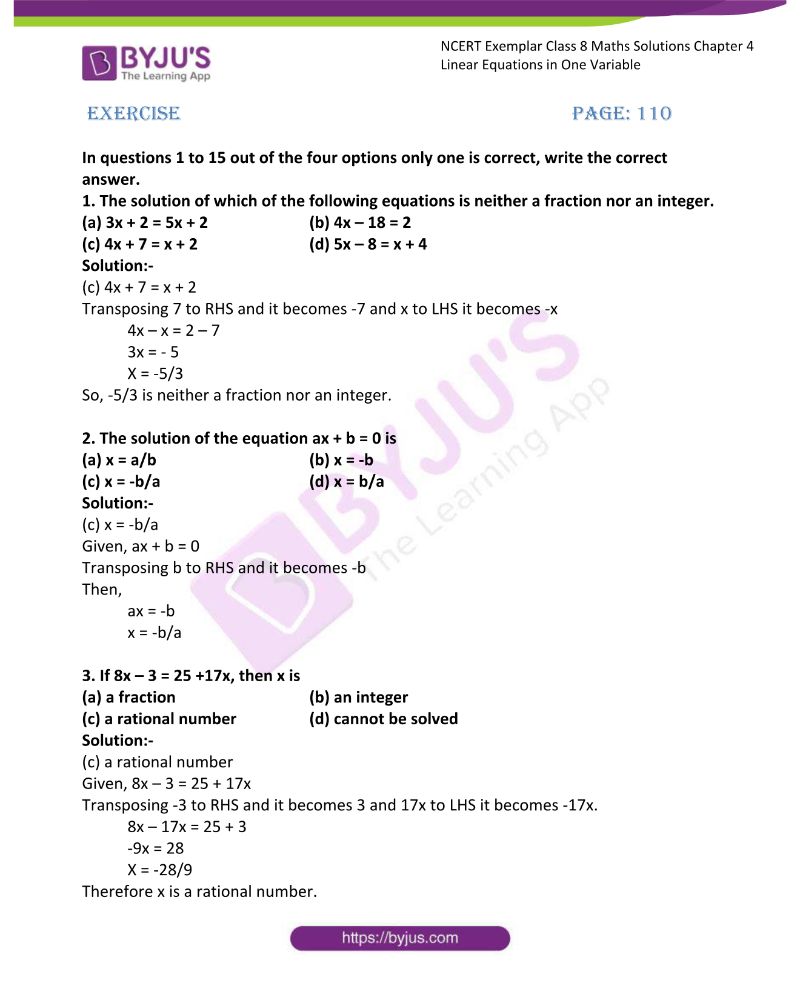
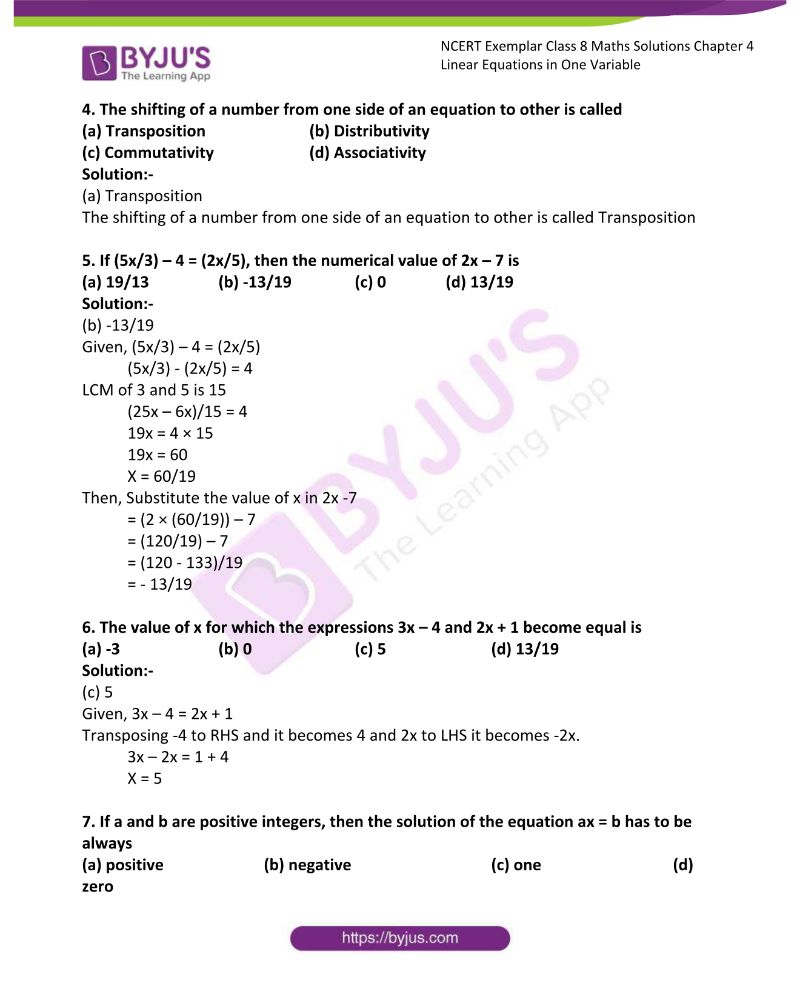
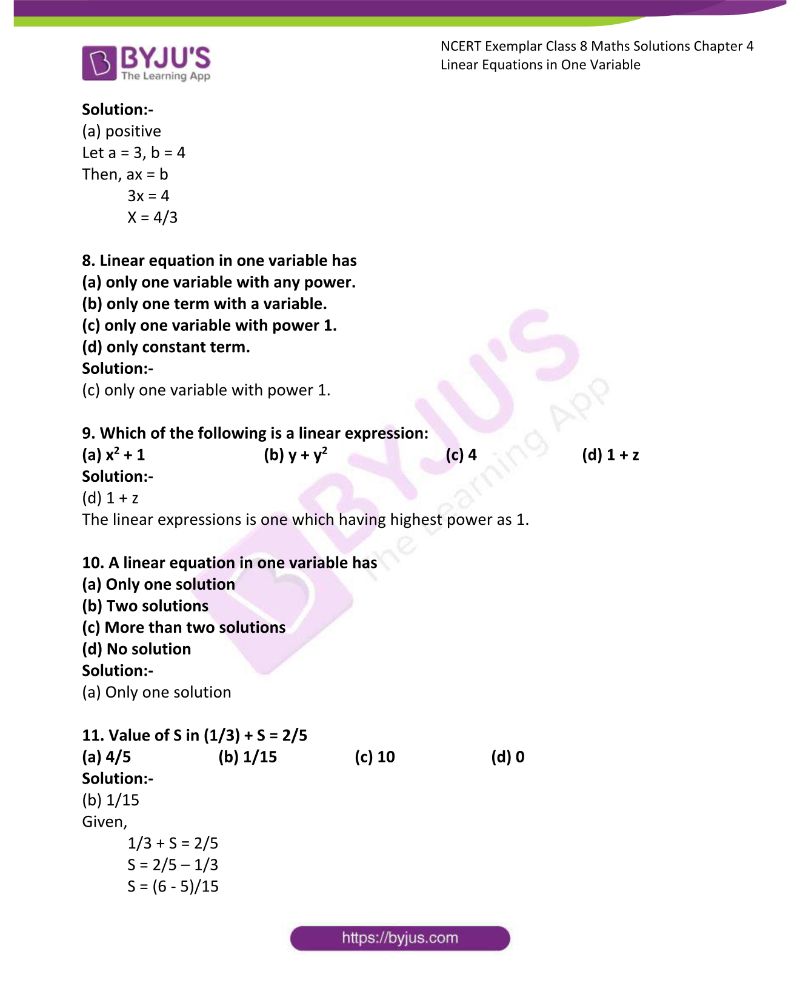
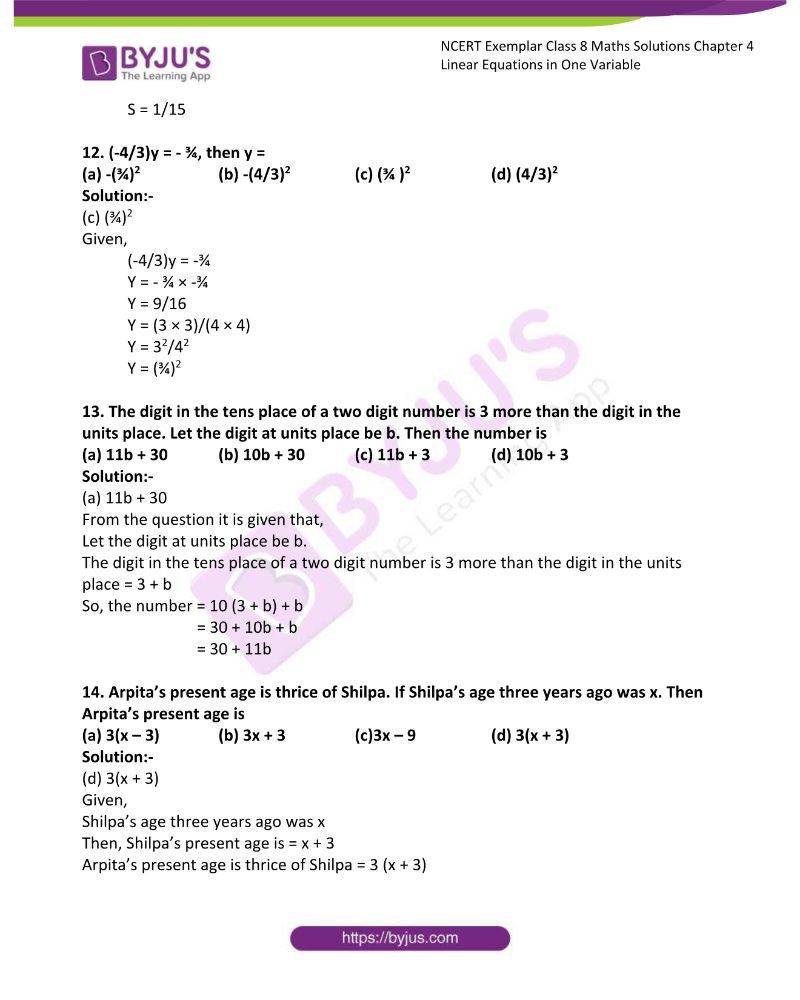
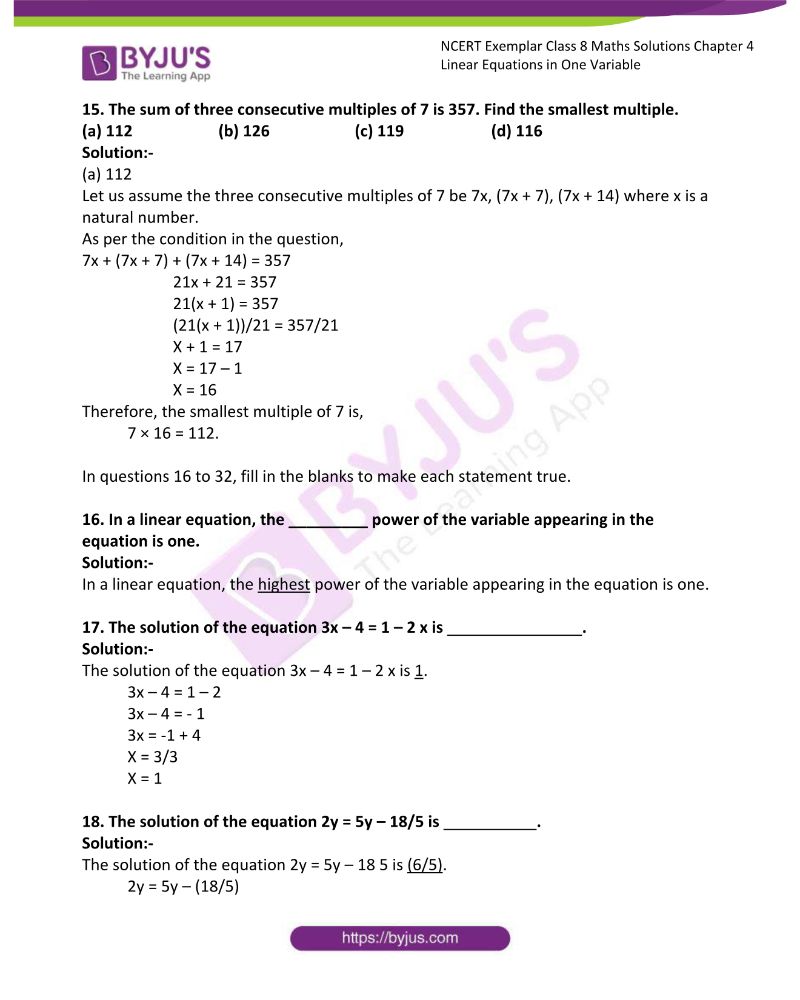
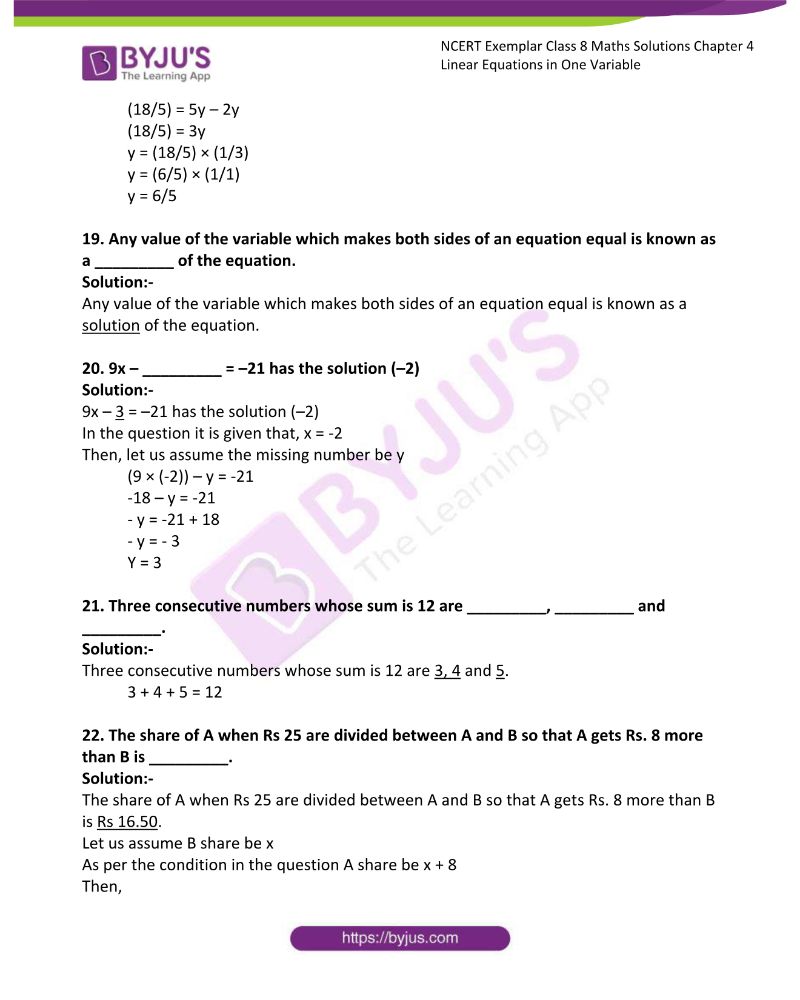
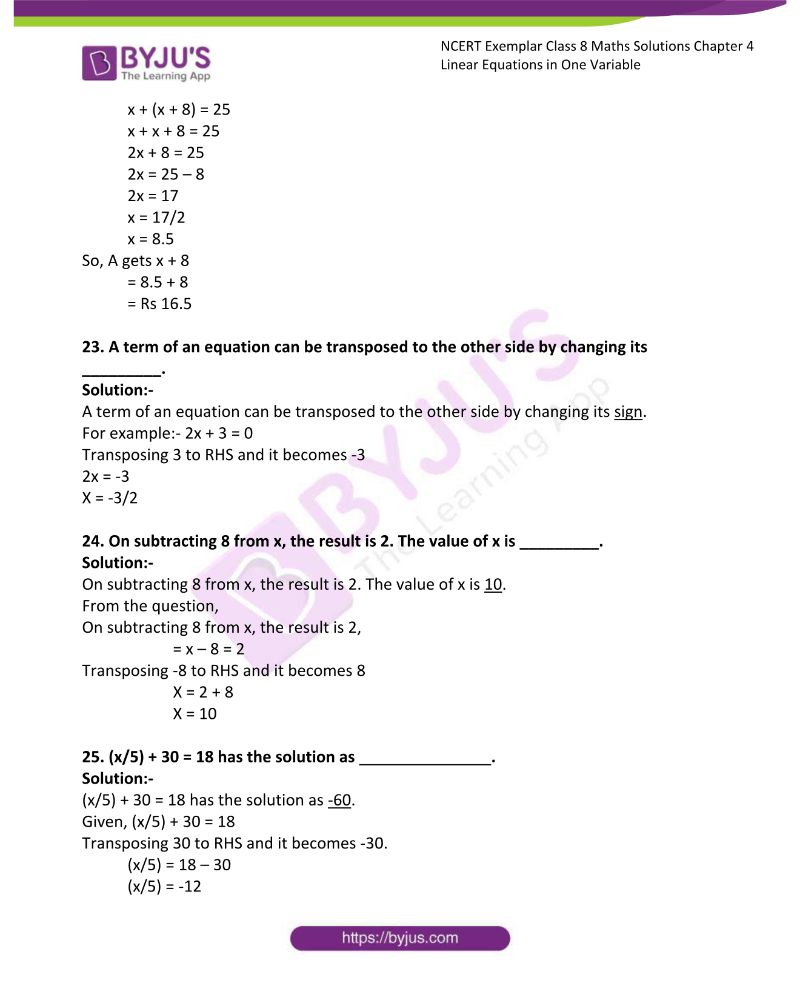


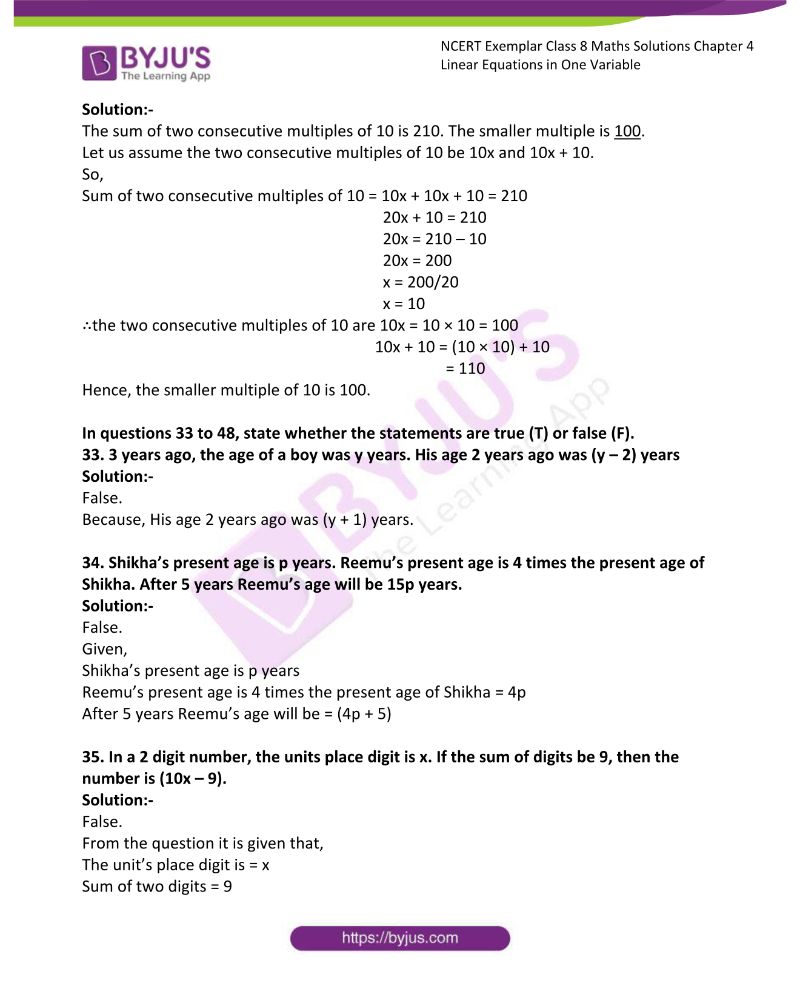
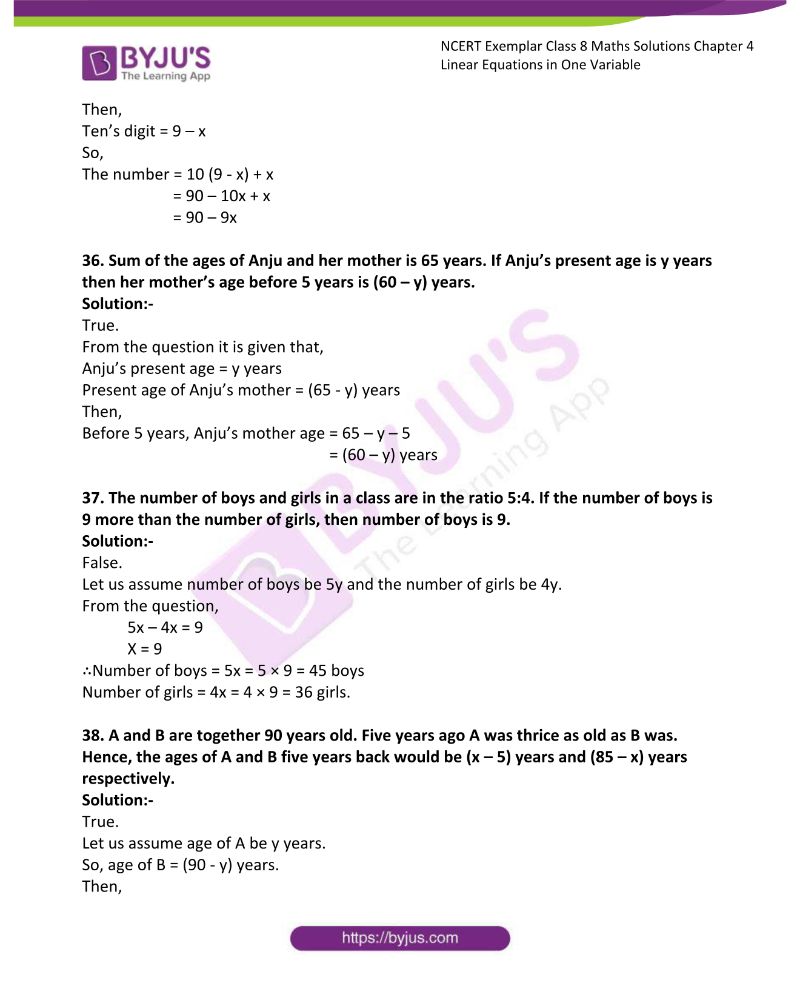
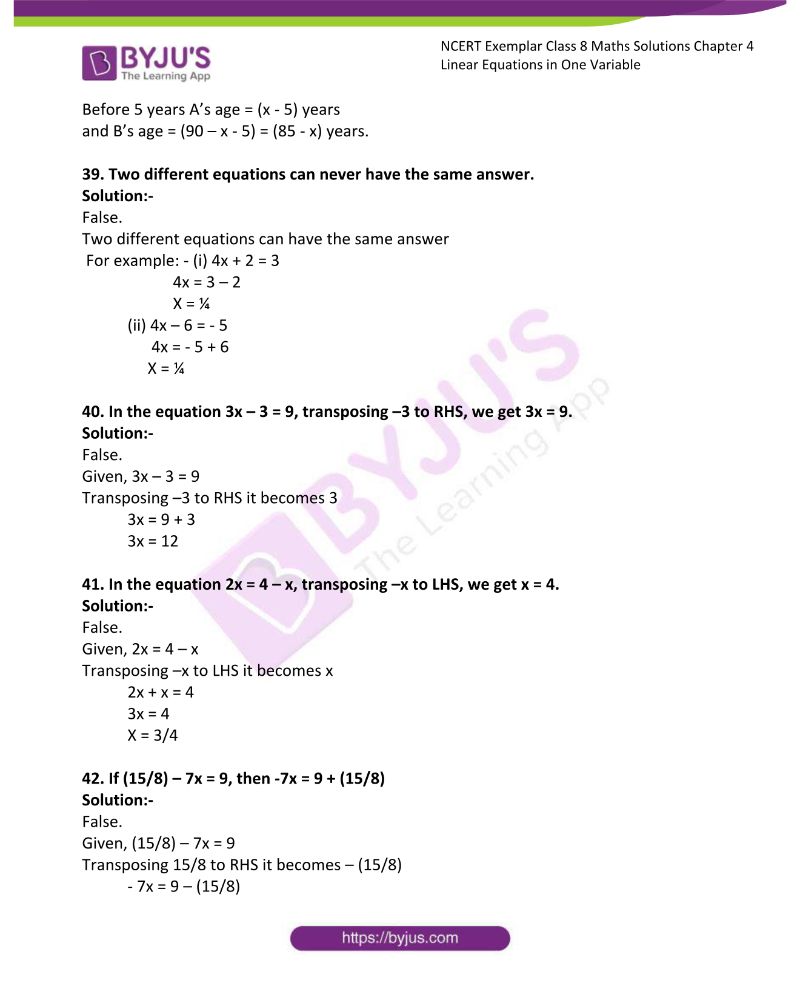
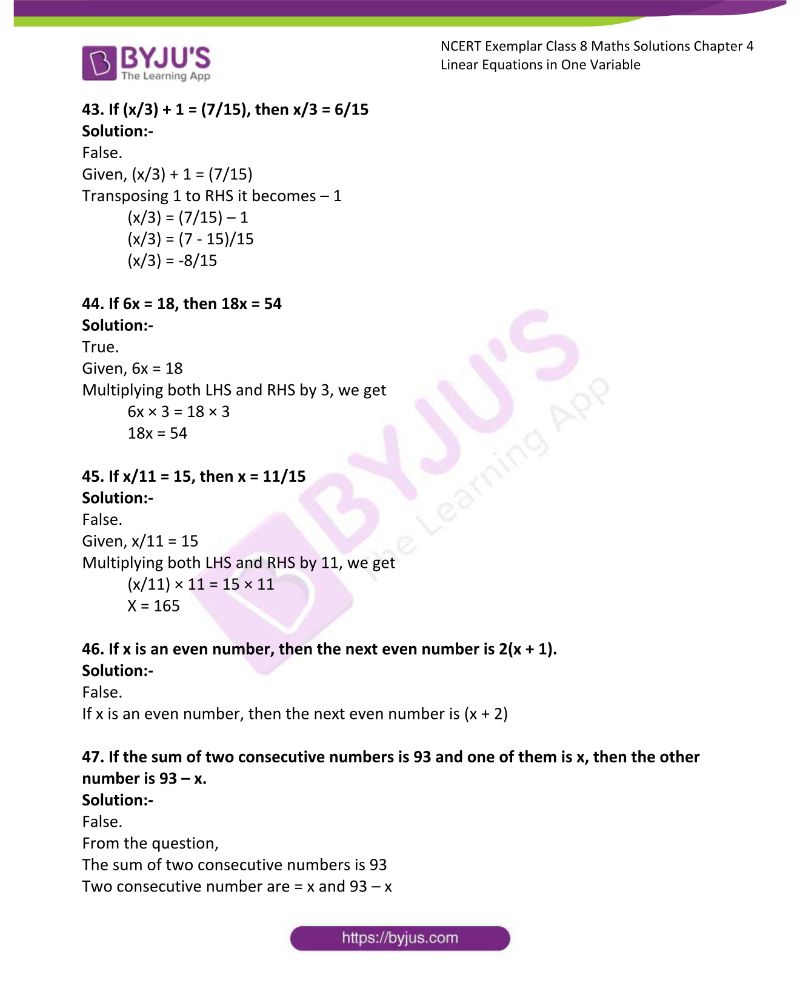
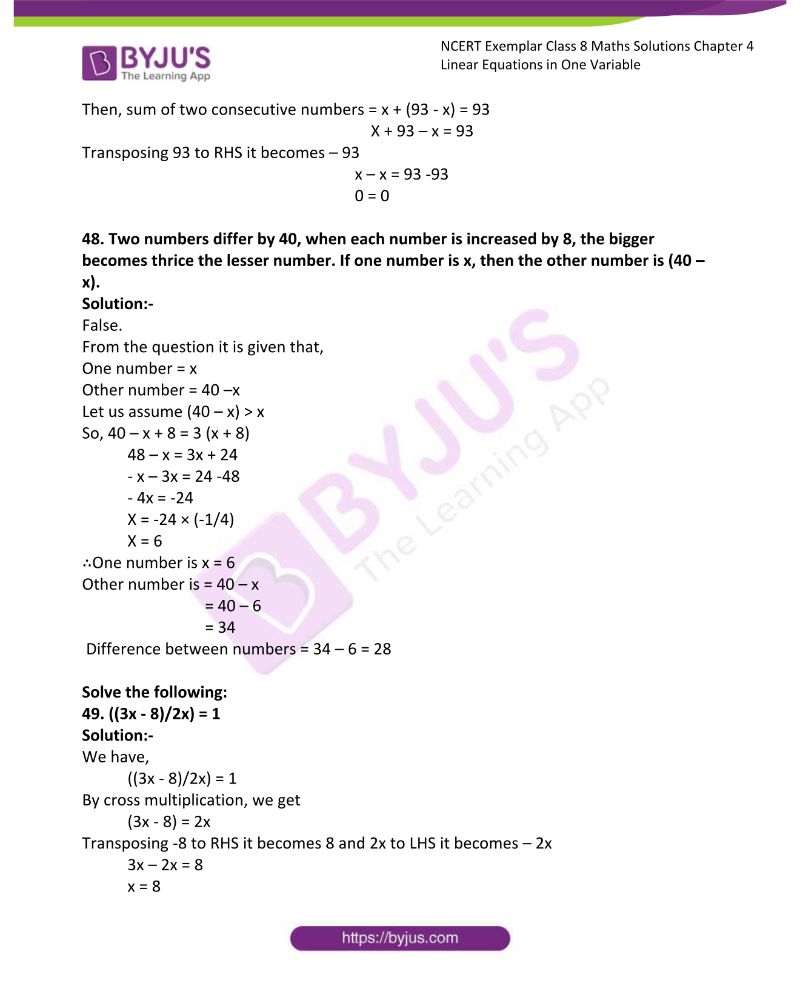
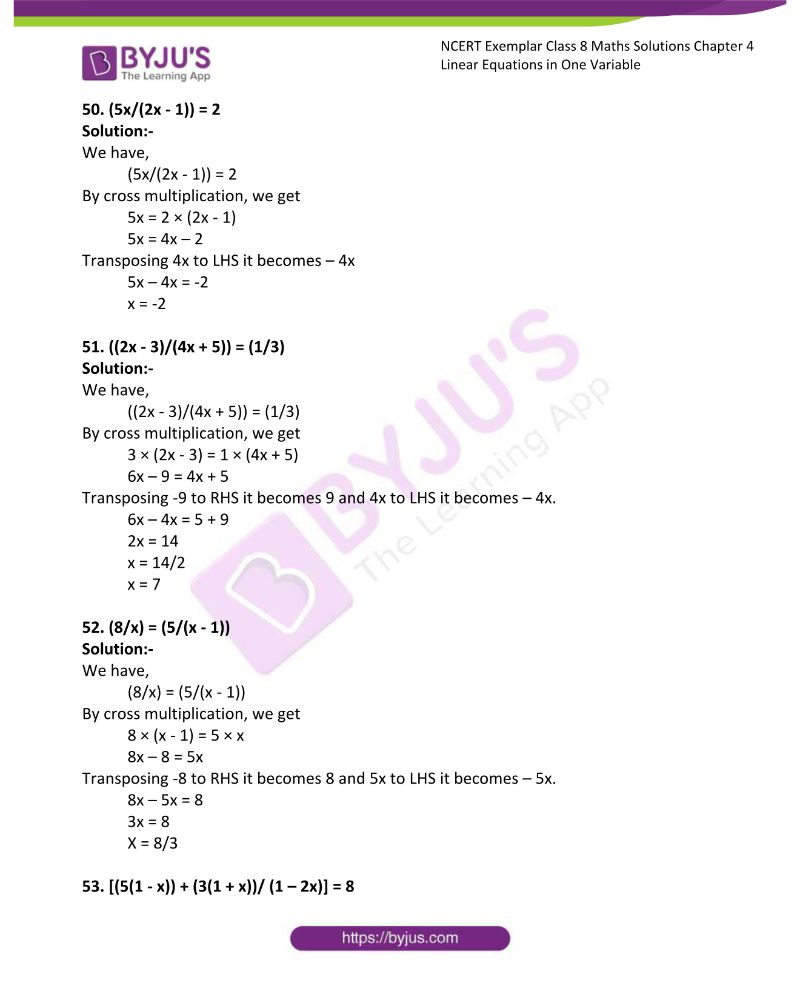
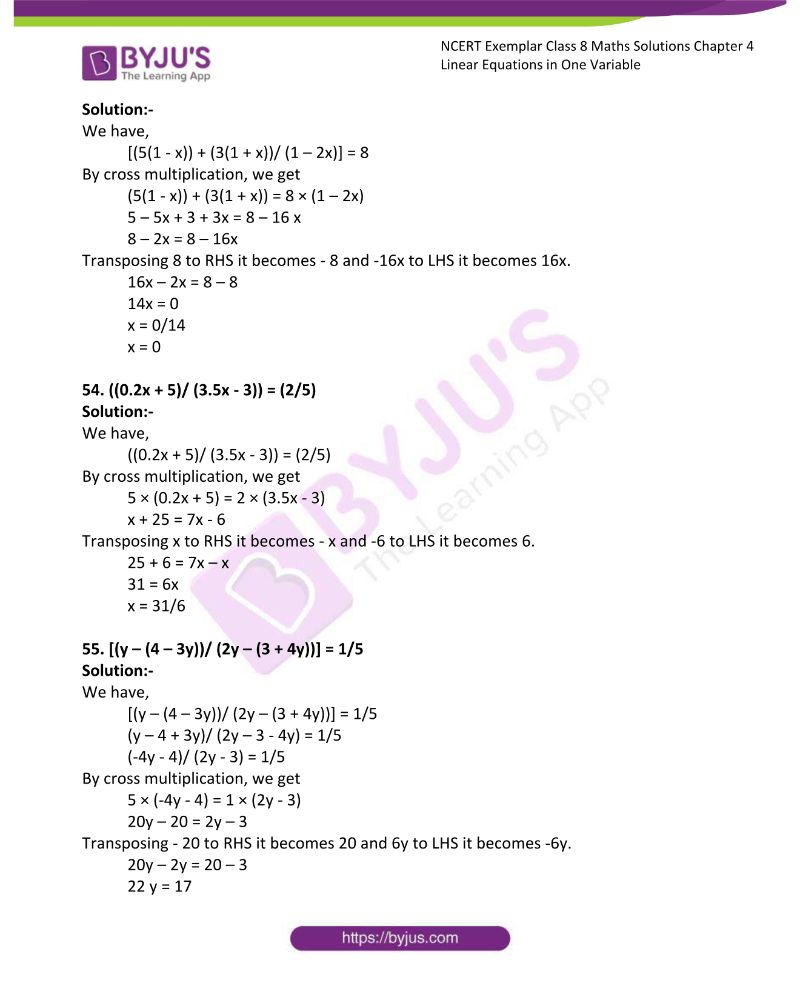
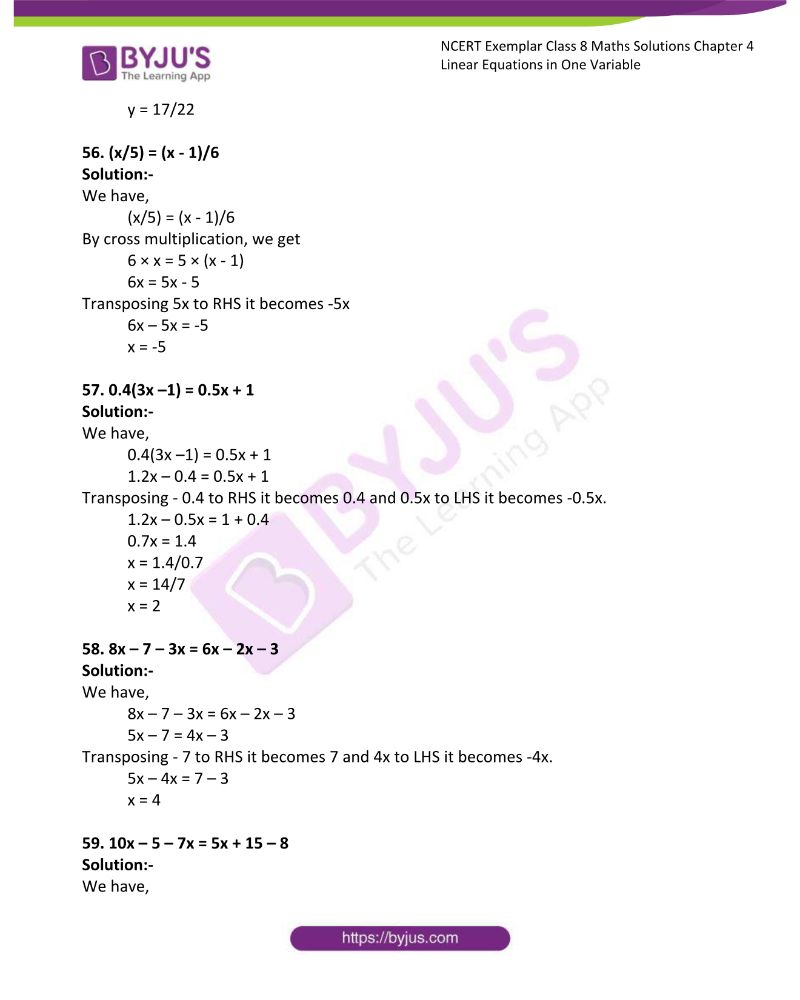
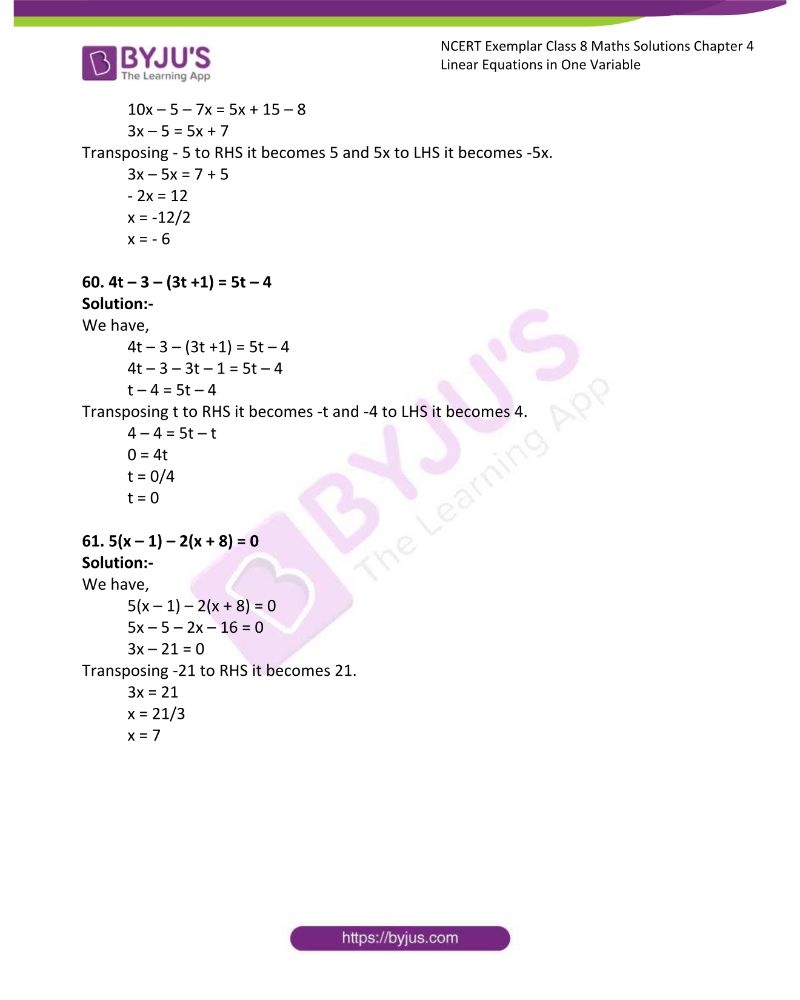
Comments